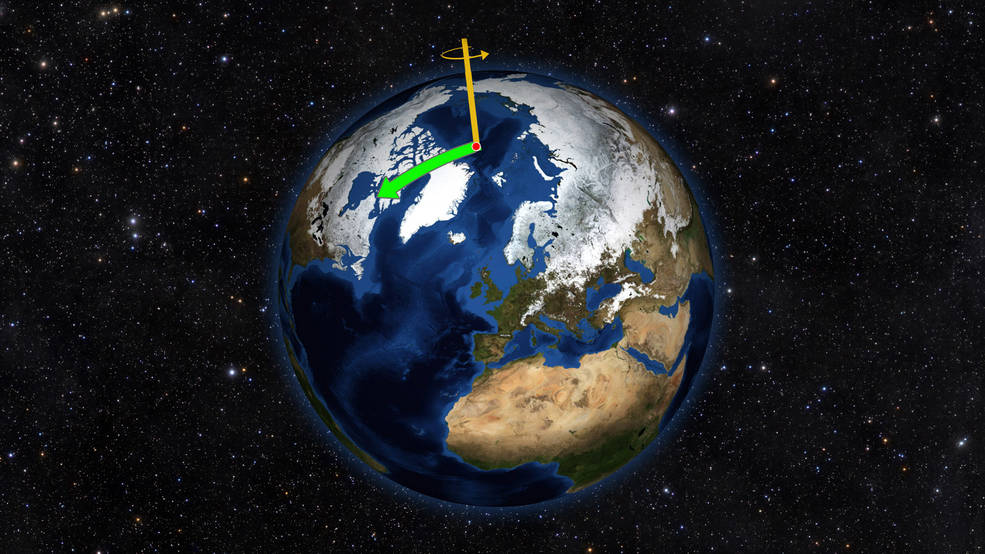Climate change has been altering Earth's axis for at least 30 years
Global warming is making Earth wobble on its axis.

Climate change has been altering Earth's poles since at least the 1990s, new research finds.
The planet's spin on its axis is determined, in part, by the distribution of weight around the globe, in the same way the spin of a top is determined by its shape. Satellite data from 2002 and later had already shown that climate change is altering this weight distribution, largely because melting glaciers and ice sheets have caused the North and South poles to drift.
Scientists had also observed polar drift in the 1990s, but uncovering the cause of that drift was tricky, because there were no direct satellite observations of water distribution around the globe from that era. Now, researchers have compared possible scenarios of total water distribution around the world and found that the best explanation for the changes to the poles in the 1990s is human-caused climate change. Melting ice sheets, combined with groundwater pumping for agriculture, altered the water distribution on the planet enough to make the planet's axis shift.
"The findings offer a clue for studying past climate-driven polar motion," said study co-author Suxia Liu, a hydrologist at the Chinese Academy of Sciences.
Related: 10 signs Earth's climate is off the rails
A changing axis
Earth's axis shifts for a lot of reasons, ranging from long-term changes in the heat-driven process of convection within the mantle to annual changes in ocean currents and winds. In 2002, NASA and the German Aerospace Center launched the Gravity Recovery and Climate Experiment (GRACE) satellites, which used measurements of Earth's gravity field to monitor changes in ice, liquid water and Earth's crust. GRACE's precise measurements allowed geoscientists to break down the various causes of polar shifts in the post-2002 era. It was clear that ice melt, driven by climate change, was having an influence. In 2013, for example, researchers reported in the journal Geophysical Research Letters that rapid melt of the ice in Greenland had caused an eastward shift of the North Pole around 2005.
Figuring out what caused polar shifts before 2002, though, required creativity. Researchers knew that polar drift shifted eastward in 1995 and that it sped up by 17 times between 1995 and 2020 compared with 1981 to 1995. But they didn't know why.
Sign up for the Live Science daily newsletter now
Get the world’s most fascinating discoveries delivered straight to your inbox.
Liu and her colleagues used the real-world observations of how the poles shifted in the 1990s and created two possible global water-distribution scenarios to see which best explained the changes. In the first scenario, the changes in water distribution around the world between 1981 and 2020 were similar to what was recorded by GRACE between 2002 and 2020. In the second, the researchers took into account observations of ice melt during the earlier period.
The second scenario, which accounted for ice melt, better matched what really happened with polar drift, Liu and her colleagues found. Ice melt from the polar regions explained most of the polar drift, the researchers reported March 22 in the journal Geophysical Research Letters; the rest was explained by water loss from nonpolar regions.
Human activity
Like climate change, these shifts in water distribution were human-caused.
"[W]atching distribution of the hotpots of the change of the TWS [terrestrial water storage], they related to popular groundwater pumping regions," Liu wrote in an email to Live Science.
Humans pump an incredible amount of groundwater for agriculture. For example, in India alone in 2010, people moved 92 trillion gallons (351 trillion liters) of water from underground reservoirs onto agricultural fields, the researchers wrote in their paper. California and northern Texas also showed large mass changes due to groundwater pumping. Because of the physics of rotation, the movement of groundwater at the midlatitudes has a stronger effect on polar drift for the same amount of water at higher latitudes, they added, so these changes add up quickly.
Overall, the changes in polar drift aren't noticeable in daily life. They might alter the length of the day by a millisecond or so over time, Vincent Humphrey, a climate scientist at the University of Zurich who was not involved in this research, said in a statement. However, there are 176 years of data on polar drift — years in which scientists have no direct measurements of water distribution around the globe. Using polar drift, scientists can work backward to figure out where the water was.
"Our next step is to extend the relationship into operational forecasting with longer reconstructed data," Liu said.
Originally published on Live Science.

Stephanie Pappas is a contributing writer for Live Science, covering topics ranging from geoscience to archaeology to the human brain and behavior. She was previously a senior writer for Live Science but is now a freelancer based in Denver, Colorado, and regularly contributes to Scientific American and The Monitor, the monthly magazine of the American Psychological Association. Stephanie received a bachelor's degree in psychology from the University of South Carolina and a graduate certificate in science communication from the University of California, Santa Cruz.










